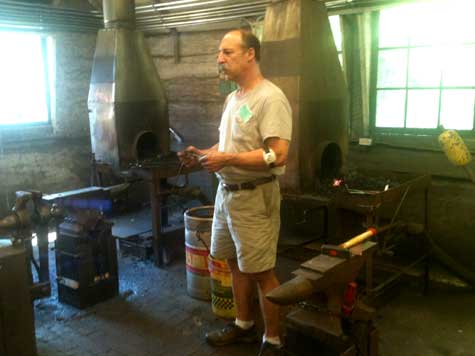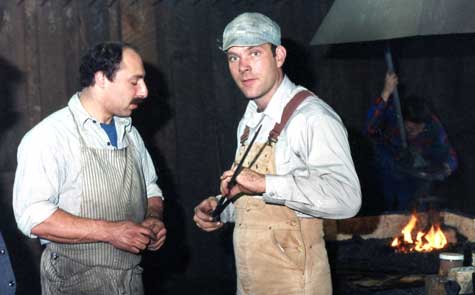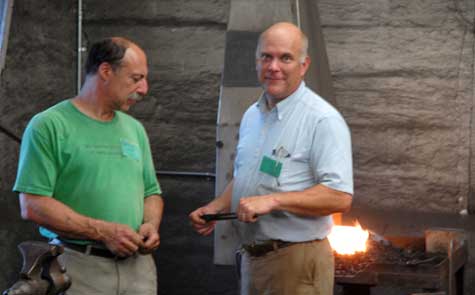
12 Jul Making Planes That Don’t Fly
I recently got the chance to take my first Woodworking class here at the Folk School. It was the “Making a Traditional Moulding Plane” class, where we made a variety of 19th century quarter sawn beech planes using antiques as examples, and using many antique tools to do the work. It was a great class that had been very skillfully prepared and presented. It was taught by Bill Anderson and Peter Ross.
Wait a minute, we know that Bill is a woodworker, but isn’t Peter a blacksmith? He is a blacksmith, who was a regular teacher here at the school for many years starting in the late 70’s. He was the Blacksmith at Colonial Williamsburg for many years, and he and Bill have been on Roy Underhill’s Woodwright’s Shop TV program. It was good to have Peter back at the school after a nearly ten year hiatus.
This class was really a mixed media class with both traditional woodworking and traditional blacksmithing as well. This made for a nice double header, where students could learn two skill in the same week. Bill handled the woodworking part of the class in the Artman Wood studio, and did so with style bringing literally hundreds of his personal (and expensive) hand tools, to make for a very effective week. Peter instructed the forging and heat treating of the blades or “plane irons as they are called” down in the old Whitaker shop.
Wait a minute, how could Peter have taught blacksmithing in the old Whitaker Blacksmith Shop after we had moved the forges out of there and into the new Spencer Shop in 2010? Well, around the time of the transition to the new building, we had the foresight to leave two working forges in place so that there were options available for this kind of thing in the future, and besides, we really couldn’t still call it a blacksmith shop without forges and anvils in it could we? It was also in respect to Francis Whitaker that it remain a functioning forge.
Another interesting thing about the week was that Tal Harris was here teaching a traditional joinery class in the adjoining Clay Spencer shop, and knowing that Peter would be there, Tal brought some old photos from years gone by here at the school. One in particular is a shot of Peter and Tal in a 1988 class taught by Peter. It was taken near the instructors forge, and shows how that end of the shop looked at that time.
I thought that since they were both here again in the same shop 24 years later, that it would be fun to re-create the photo as close as we could to the original. Richard Babb, the photo instructor that week was pressed into service since he was handy and had the most expensive looking camera in the crowd. We shot the photo near the front door and the forges there, while the old photo was taken in the back of the shop where the instructors forge was then. It is now where the steps and the doors to the new shop are located.
I also got Tal and Peter to write up some thoughts about that class and what they remembered about the school back then.
Tal writes: “Here’s the picture of Peter and me…sometime around the end of November, 1988. At that time the floor was dirt, the student forges had hand crank blowers, and the metal storage was vertical against the back wall. It was a very cold week, and each morning we broke an inch of ice to enable dipping water from the slack tubs. There being no heat in the shop other than the forges, it didn’t take long for everyone to start working each day, and the meals (which were served in the dining room underneath Keith house) were much anticipated and the blacksmiths quickly earned the reputation of clearing the extra food from all the other tables. Clay Spencer was a student that week as well as my friend Jimmy Freeze. Peter named Jimmy and I the “toaster twins” as we both made hearth toasters that week.”
Peter writes: “As Tal says, the place was smaller then, and the dining hall was in the basement of Keith house. Some of the weekly sessions were only big enough to fill three or four tables. When I was here in summer, the sawmill and planing mill were in operation and the whine from those machines permeated the campus all day long. David Brewin was the resident smith back then, and lived in Mill House. By the time Tal and Jimmy “the twins” took their class, the shop had been much improved. There was no heat in the winter, and Tal remembers correctly that it was freezing in there. By lunchtime, it would get up to 34 degrees or so. Mealtimes were for more that just eating- it was a relief to finally warm up and see clean faces for a change.”
“The floor could have been dirt, though over the years, many things were tried including clay, sawdust, brick, and cinders. The class shown in this photo was on making hearth cooking tools and equipment. There was some freedom given to the students to choose projects, so Tal and Jimmy made their fateful choice. By the way, they both made beautiful toasters, and I think they are both still in service toasting bread. The shop had some powered equipment such as a power hammer and a grinder, but classes were almost entirely based on forge, anvil, vise and hammer. Occasionally some filing was done.”
This is some interesting insight on how things were, and how far the school has come in twenty four years. With any luck we can take this picture again in another couple of decades. Stay tuned.







No Comments